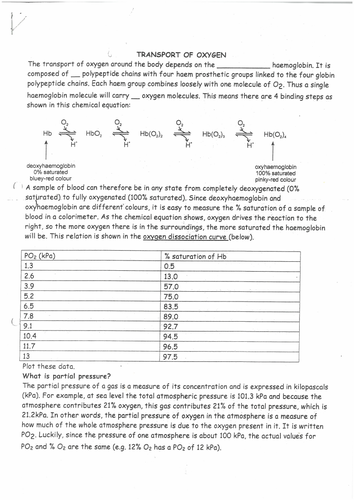


The booklet covers the difficult concept of how haemoglobin transports oxygen around the body and how the haemoglobin undergoes configurational change so that it bonds oxygen more easily after the first oxygen has joined.
The booklet then introduces Oxygen dissociation curves why they are sigmoid shape and how they are made including what the partial pressures means in terms of tissues in the body.
There are various amount of tasks in the booklet students are challenged to make a dissociation curve with some data and need to answer some key questions on what is happening at different parts of the graph in relation to partial pressure and haemoglobin shape.
The booklet then compares haemoglobin with both myglobin the oxygen storage molecule found in muscles and foetal haemoglobin. Both have questions on what these molecules do and where they are situated on the oxygen dissociation curve graph in relation to adult haemoglobin.
The booklet then introduces carbon dioxide transport in great detail and the three main methods it is transported in the blood.
The booklet then finishes on the Bohr effect and how carbon dioxide affects the oxygen dissociation curve and what happens when different carbon dioxide concentrations affect haemogobin loading and unloading.
Something went wrong, please try again later.
This resource hasn't been reviewed yet
To ensure quality for our reviews, only customers who have purchased this resource can review it
Report this resourceto let us know if it violates our terms and conditions.
Our customer service team will review your report and will be in touch.